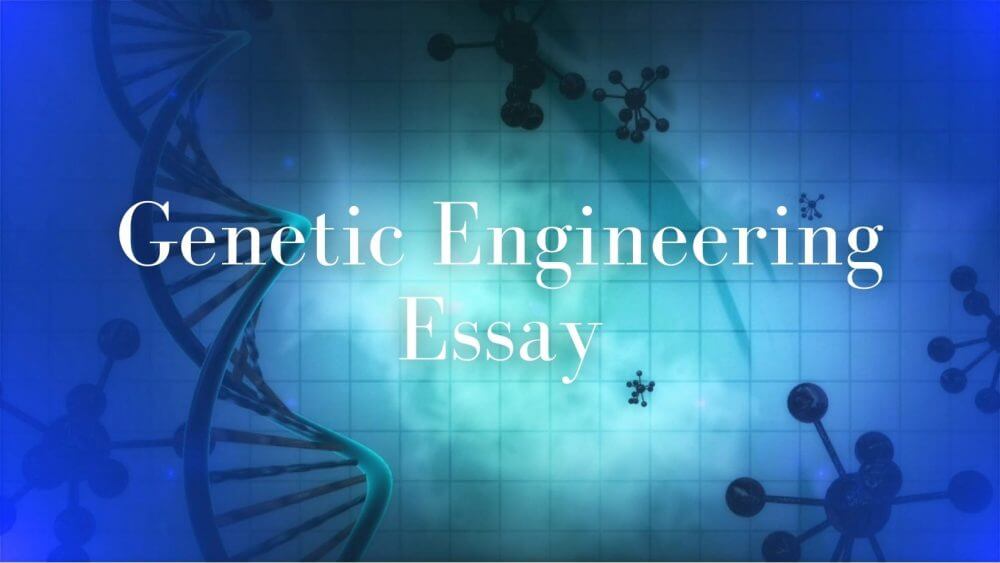Genetic engineering has been a subject of heated debate. You will find many essays on genetic engineering, asking you to debate for or against, discuss its ethical implications, or emerging congenital disease.
With all these at hand, you may be tempted to opt-out immediately. However, this top-notch guide seeks to make genetics essay writing as fun and as straightforward as possible. Ride along to see the magic!
What Is An Essay on Genetic Engineering?
Now, genetic engineering in itself is the use of biotechnology to manipulate an organism’s genes directly. Therefore, essays on genetics will require students to explore the set of technologies used to change cells’ genetic makeup. These include the transfer of genes within and across species boundaries to produce novel or improved organisms.
We have various areas of genetic engineering, such as:
- Human genetic engineering definition: Deals with genetic engineering techniques applied to humans
- Genetic engineering in plants: Concentrates on genetically modified plant species
Genetic engineering is mostly applied in medicine and thus its technicality. I know this is a field that most students approach with reverence and uttermost humility. Nonetheless, it doesn’t have to be that way. The next few lines might change your opinion on genetic engineering forever!
Why is genetic engineering necessary?
Importance of Genetic Engineering
It is essential in the following ways:
- Ensures that seed companies can protect modified seed varieties as intellectual property.
- Leads to production o organisms with better traits
- Helps maintain the ecosystem
You can see why this field is unavoidable regardless of the negative talk behind it.
Genetically Engineering Plants and Animals – Essay Sample
Young in practice, a little over forty years old, genetic engineering has provided the scientific community with an abundance of knowledge once thought absurd. Genetic engineering means deliberately changing the genome of an organism to acquire some desired traits during its cultivation. On the whole, genetic engineering has a multitude of advantages and disadvantages when it comes to using it on animals and plants; the most prominent advantages include disease resistance, increased crop yields, and a decrease in need for pesticides and antibiotics, whereas disadvantages include the potential for emergence of stronger pathogens, as well as various unexpected consequences. This current paper discusses the pros and cons of using genetic engineering on plants, animals, and provides a synthesis, arguing that, despite its disadvantages, it still serves as a pivotal advantage not only within the scientific community, but also society.
The Advantages of Using Genetic Engineering
The impact of genetic engineering on society can be seen at various aspects, affecting various aspects of social and physical organic life, especially in terms of human beings. The practice consists of the specific selection and removal of genes from organic organisms and inserting them into another. The practice, though still young in practice and not yet deemed completely socially acceptable, makes the possibility of curing diseases once thought incurable a reality, thereby inherently improving the life of both humans and non-human animals. It has many positive effects on society, an example being in Uganda bananas, a main source of caloric intake, are susceptible to the emergence of new diseases that affects their production because of the disease’s potency. Ugandan scientists have successfully used a genetic modification, inserting a pepper gene into bananas, which prevents the fruit from getting the disease (Bohanec, 2015). Furthermore, through genetic engineering, tissue, skin cells, and other forms of organic matter can be grown and used in replacing damaged, worn, or malfunctioning organs and tissues thereby prolonging human life and benefiting their quality of life. The practice helps better advance both the scientific and medical field, both of which are essential in discovering how to better life on Earth.
Genetic engineering, as previously mentioned, can be used to grow and replace damaged tissue or organs, aiding in the betterment and prolonging of human life; it can cure diseases once though incurable, an example being AIDS and cancer. Millions of people around the world suffer from AIDS and cancer, both posing a severe risk to the overall health of the person. More than 900,000 lives were taken by AIDS in 2017 (UNAIDS, 2018). Similarly, over 600,000 were taken by cancer in the following year (NIH, 2018). Genetic engineering makes the possibility of eradicating these diseases a reality. In theory, genetic engineering can help those who suffer from these diseases live longer, healthier, fuller lives by eradicating the disease in its entirety. Though it would not be an easy feat, nor a cheap one, it could still help further advance and better human life and prolong the human life span. People would no longer live in fear of dying from these prolific diseases. Furthermore, genetic engineering, despite the naysayers and opposers of the practice, is another step in organic evolution. From plants to animals, the practice has the chance to achieve strides within scientific history that can greatly benefit the planet in its entirety. From eliminating hunger, to eradicating once prolific diseases, genetic engineering can provide a better, longer, and higher quality of life and tackle bounds once thought impossible the scientific community.
Genetically engineered plants and animals may provide a wide array of benefits that might be pivotal for humanity in the modern world. These benefits include the possibility of developing such plant cultivars that would be resistant to a wide variety of pathogens and diseases caused by microorganisms such as viruses (Ginn, Alexander, Edelstein, Abedi, & Wixon, 2013). If such plant cultivars are created, it might become unnecessary to use chemicals in order to battle these plant diseases. This is clearly a major benefit, since it means better preserving the natural environment and avoiding the use of chemicals that may contaminate soils and waters, as well as kill wildlife.
The Disadvantages of Using Genetic Engineering
The use of genetic engineering to alter plants and animals used in agriculture and husbandry may also have a variety of adverse consequences. For instance, it should be noted that high rates of resistance to disease might have a serious flip side. More specifically, the pathogenic microorganisms (such as bacteria and viruses) can usually mutate quickly in order to adapt to the new conditions. This means that if new cultivars or breeds of plants or animals with high resistance to diseases are created, the pathogens may adapt to these changes in their “hosts” and turn stronger, thus becoming capable of infecting the new cultivars or breeds (Ayres, n.d.). This might again necessitate the use of chemicals or antibiotics; only now stronger drugs or pesticides would be needed. In addition, the old cultivars or breeds may also become infected by the new microorganism strains, and these strains will probably cause more severe diseases in the “original” plants and animals and will be more difficult to cure or prevent.
Another negative possibility is accidentally creating some invasive species that may harm the local ecosystems. For instance, if new plants are made in such a manner that the local species of animals cannot eat them, and then humans lose control over their growth, the new plants may pose a danger to the original plants growing in the given ecosystem, therefore disrupting the ecosystem. For example, in 1984 a patch of seaweed labelled as Caulerpa taxifolia was bred with another robust strain of seaweed identified by scientists as Caulerpa taxifolia (Vahl) C. Agandh. The initial objective was to breed an aquarium plant, however, after a sample escaped in 1984 into the Mediterranean Sea, being found off the coast of both the United States and Australia in 2000, it was found that the strain’s taste was subpar to marine wild life. It was eventually poisoned by the California state government to avoid further damage to marine life and the marine ecosystem and was consequently outlawed by hundreds of countries. The World Conservation Union named it one of the 100 World’s Worst Invasive Alien Species, despite it being manmade (Cellania, 2008).
Finally, there is always the risk of “going too far” when practicing genetic engineering (Bruce & Bruce, 2013). Indeed, it should be noted that the humanity has used various methods of cultivation for millennia in order to breed for specific traits. For example, in 1956, Warwick Kerr, a Brazilian geneticist, imported an aggressive breed of African honeybee to breed with a European species to aid in the decreasing bee population epidemic. Provoked by even the smallest of instigation, after over 26 swarms of the aggressive bee escaped from the apiary in Sao Paulo, they wreaked havoc in North and South America, found in the United States in the early 90s. Nevertheless, genetic engineering is a fast and radical method to change organisms, and very little, if any, data is available to predict the potential adverse impacts of its utilization. It may be difficult to tell when (if at any point) one must stop the process of genetic engineering to avoid unexpected adverse influences of its utilization.
Conclusion
Genetic engineering, despite its disadvantages, can help progress humanity in ways that once seemed impossible. With the environmental and physical epidemics surrounding the planet, the practice can serve as a benefit to resolving the hunger crisis, the preservation of endangered plant and animal species, bringing certain species back from extinction, and so much more. It should be stressed that the utilization of biotechnology and genetic engineering may bring a wide array of significant benefits, which may be of great use to the humanity nowadays. The creation of breeds and cultivars which are immune to disease, resistant to harsh environmental conditions, are cheap to grow, and provide better nutritional value for people might be extremely helpful in reducing the amount of chemicals, pesticides, and antibiotics needed to grow these animals or plants, and, consequently, to help preserve the environment. However, it should also be remembered that genetic engineering might have a wide array of adverse impacts, such as the emergence of new, stronger pathogens, the creation of invasive species, and a multitude of negative consequences that no one knew to expect.
Genetic Engineering Essay Structure
A top-rated genetic engineering essay comes in the manner outlined below:
- Genetic engineering essay introduction: Provide context for your paper by giving a well-researched background on the subject of discussion. Include the thesis statement which will provide the direction of your writing.
- Body: Discuss the main points in detail with relevant examples and evidence from authentic and reliable sources. You can use diagrams or illustrations to support your argument if need be.
- Genetic engineering conclusion: Finalize your paper with a summative statement and a restatement of the thesis statement while showing the genetic engineering process’s implication. Does it add any value to society?
Armed with this great treasure of knowledge, you are good to begin writing your paper. However, we have quality genetic engineering essay topics from expert writers to start you off:
Interesting Genetic Engineering Persuasive Essay Topics
- How human curiosity has led to new advancements and technologies in genetics
- History of genetically modified food
- Discuss the process of genetic engineering in crops
- Evaluate the acceptance of genetically modified crops worldwide
- Analyze the leading countries implementing genetic engineering
- Does genetic engineering produce a desired characteristic?
- What are the legal implications of genetic engineering
- The role of scientists in making the world a better place
- Why coronavirus is a game-changer in the field of genetic engineering
- The effectiveness of genetic engineering as a course in college
Great Topics on the Disadvantages of Genetic Engineering in Humans
- Why changing the sequence of nucleotides of the DNA affects human code structure
- Impact of genetic engineering human lifespans
- Genetic engineering and population control
- Ethical questions to consider in human genetic engineering
- Unintended side effects on humans
- Increasing the risk of allergies
- The foundation of new weapon technologies
- Disadvantages of trait selection before birth
- The greater risk of stillbirth
- Why ladies are at risk with genetic engineering
Why is Genetic Engineering Good Essay Topics
- Genetic engineering and disease prevention
- The creation of a healthy and better society
- Production of drought-resistant crops
- Crop pollen spreads further than expected
- Survival of human species
- Birth of healthy children with desirable traits
- Solving food insecurity problems globally
- Elimination of fertility issues for couples
- Medical advancements as a result of genetic engineering
- Reducing the prevalence of schizophrenia and depression
Good Genetic Engineering Topics
- The development of genetic engineering in the modern world
- Application of ethics in genetic engineering
- Societal class versus genetic engineering
- Impact of genetic engineering on natural selection and adaptation
- Detection of toxins from GMO foods
- Social effects of genetic engineering
- Why people are becoming increasingly resistant to antibiotics
- How gene editing affects the human germline
- Medical treatment opportunities in genetic engineering
- The relationship between molecular cloning and genetic engineering
Impressive Genetic Engineering Research Paper Topics
- Impact of genetic engineering on food supply
- The taste of GMO food versus ordinary food
- GMOs and their need for environmental resources
- Why genetic engineering may face out the use of pesticides
- Reduced cost of living and longer shelf life.
- Growth rates of plants and animals
- Application of genetic engineering on soil bacteria
- New allergens in the food supply
- Production of new toxins
- Enhancement of the environment for toxic fungi
Latest Genetic Engineering Ideas
- The discovery of vaccines through genetic engineering
- Biological warfare on the rise
- Change in herbicide use patterns
- Mutation effects in plants and animals
- Impact of gene therapies
- Does genetic engineering always lead to the desired phenotype?
- Genetic engineering in mass insulin production
- Role of genetic engineering in human growth hormones
- Treating infertility
- Development of monoclonal antibodies
Pro and Cons of Genetic Engineering in Humans Topic Ideas
- Possibility of increased economic inequality
- Increased human suffering
- The emergence of large-scale eugenic programmes
- Rise of totalitarian control over human lives
- The concentration of toxic metals in genetic engineering
- Creation of animal models of human diseases
- Using somatic gene therapy on Parkinson’s disease
- Production of allergens in the food supply
- Redesigning the world through genetic engineering
- Bioterrorism: A study of the issue of emerging infectious diseases
I believe that by now explain genetic engineering in a sentence and write an essay on it effortlessly. If this still seems complicated for you, we have professional essay writers at your disposal.
You are sure of trustful, custom essay writing help at the convenience of your bedroom study table. It is cheap and high-quality.
Place your order online today!


















